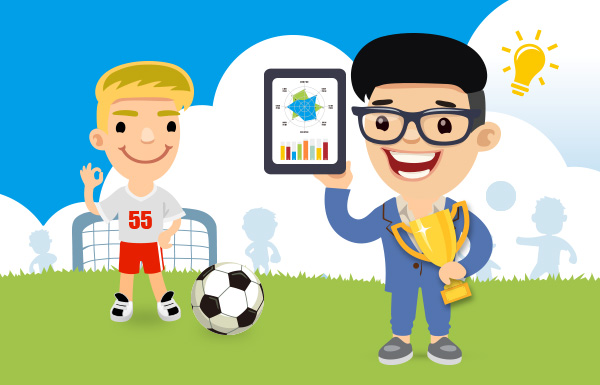
It seems that nearly every week, we’re subjected to news about the ever-changing impacts technology has on our lives. Whether it’s setting up a smart home, trouble shooting a bluetooth connection, using our social media accounts or shopping online, we’re generating countless amounts of information.
As we’ve looked at [HERE], this online behaviour generates treasure troves of data. And as we’ve alluded to [HERE], those who know how to analyse, contextualise and interpret the data have the ability to drive their businesses into the future.
But what about our activities after work? How do you unwind after a long day at the office? For many of us, it’s as sport spectators and fans.
While few of us would automatically associate sports with big data, we need look no further than the 2018 FIFA World Cup to see fascinating new ways big data is impacting and improving the sporting world. Before heading into the field (we love our business/sports puns), we’re hoping that FIFA’s embrace of big data can encourage you to think about ways to improve your overall business intelligence – and specific ways to grow your business through big data.
FIFA’s World Cup 2018 and Tracking Analytics
In an unprecedented move, FIFA recently allowed for the introduction of in-game player analysis through Electronic Performance and Tracking Systems (“EPTS”).
In FIFA’s own words, “EPTS are technologies used to monitor and improve player and team performance.
EPTS primarily track player (and ball) positions but can also be used in combination with microelectromechanical devices (accelerators, gyroscopes, etc.) and heart-rate monitors as well as other devices to measure load or physiological parameters.
If you’ll allow us to get slightly technical for a moment, let’s explore that a bit more. The FIFA approved system is currently spread across 3 categories: (1) Optical-based tracking systems, (2) Local positioning system and (3) GPS (Global Positioning System)/Global Navigation Satellite System (GNSS).
How do these systems work, what are their merits and limitations and what sort of data is now available to analyse?
The first type, optical-based tracking systems are done by placing cameras throughout the stadium. These systems are non-invasive to players, are already commonly used and, with a sample rate, allow for extremely accurate ball tracking.
The second type, local position systems, are worn by the soccer players. Most often designed to be small, lightweight devices sewn into a jersey, these provide a high number of measurements, real-time accuracy and broadcast over an ultra-wide band that reduces the chances of transmission interference.
The third type, GPS/GNSS makes an even higher number of measurements possible, installs quickly and does not need constant operating.
This technology can be housed in the same or similar unit to the local positioning systems.
So what type of data can be gleaned? And why does it matter?
The Impact
Traditionally, a coach might refer to rudimentary player stats – game/season averages for goals scored, goals assisted, points scored, points assisted, goals allowed/saved, etc.
A solid career coach would also have interpersonal knowledge to seemingly just KNOW when a player was underperforming – the best coaches can seem like magicians, analyze player interactions and refining game strategy on-the-fly.
Could technology eliminate the need for years of on-the-field and off-the-field pre and post-game analysis?
Not quite.
Data doesn’t eliminate this aspect of the coaching craft, but it does explode its potential. The granular level data that’s now available to managers and coaches would have been simply unthinkable just a few years back.
By way of examples – let’s say you’re in warmups and your star player is looking a bit sluggish. By consulting your tablet or smartphone, you can see information gleaned from his wearables. Maybe he didn’t get enough sleep last night or ate an unhealthy breakfast – his blood sugar levels seem off and his heart rate slightly more elevated than you’ve come to expect. Or maybe the device pinpoints a minor injury that he hasn’t mentioned to you and that isn’t visible to the naked eye.
What if the data from your star goalie shows that she’s been over training?
What if your new halfback seems to be suffering from balance and acceleration setbacks?
And since we’re talking about World Cup caliber players here, it’s fairly safe to say players would be aggressively self-monitoring in the hopes of constantly improving their game.
Over the the course of a given season, players’ characteristics could be better tracked and understood. Analysis of generated data could be used to improve, enhance or even just fix player performance. Specific areas of weakness could be targeted, reducing the chances of injury from poor form or over exertion.
What if you were to study data provided by the ball?
Combined with player profiles, you would know something was off when your starting forward wasn’t steering the ball with the same intensity and during practice.
Taken in pieces, these bits of data are certainly interesting. But the bigger potential might be seen in relational data.
By refining some algorithms, you could develop a visual network for your team. A team at Northwestern University in the United States has done this. In their model, each node/circle represents one player, with the size of the node/circle determined by the influence the player has. Lines connect all the players – the wider the line, the stronger the connection between those players.
Suddenly, you’re not just looking at individual pieces but the way the system (team) operates as a whole.
The Current Reality
It could be said that coaches aren’t limited so much by the data they will be able to collect going forward, rather by limitations in how they are able to analyze and pivot strategy based on that data. Employing big data analysis is not an easy task for the clubs to undertake.
A coach, manager or league will need to find and employ people who are trained to “crunch” the data. Especially in sports, we need to consider those aspects that are harder to assign a number to – a player’s shifting work ethic/attitude (i.e. how they treat authority figures on/off the field, how they treat their teammates, how they handle adversity).
And then there’s the consideration that, just as in life, sports is not all about the numbers.
It’s about passion and craft.
It isn’t a stretch to say that player performance can be impacted in less predictable ways by things such as fan behavior.
Before we turn back to the world of business, we want to stress that big data can’t give us the answer as to who will be this year’s World Cup champion. It does, though give us highly valuable information – such as the likelihood of certain teams making the playoffs. The probability.
Big Data and Your Business: What’s the connection?
The business parallels might not seem glaringly obvious – but they’re certainly there.
Think about the way the game is played.
Constant action.
In a 24-hour global business cycle, your customers can be seen to be in constant action as well.
Even if they aren’t, you need to a crystal clear understanding of what drives your customer “on and off the field.” And if we were to stretch the analogy to Northwestern’s research – your customers can be seen as a system of sorts. While they might not rely on each other the way members of a team do, many have strong connections to potential customers.
In any case, when framing the big data question – perhaps you can think not so much what your data is good for – but rather how using it can improve your business intelligence your customer relationships.
So – what are you doing with the data you collect? How can you synthesise the information available to you? How can your company leverage that data?
That’s where we come in… Introv can help you develop a holistic information management strategy that incorporates your traditional data sets with newly acquired and available data. Contact us today to find out how.
About Introv
We are an award-winning, full service IT & Business Management Consultancy Service Provider in APAC. We offer best-in-class collaborative software solutions to companies of all sizes, looking to improve the operational excellence of their business.
Get a free consultation with us today!













